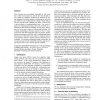102 search results - page 20 / 21 » Pseudo-Exhaustive Testing of Sequential Circuits |
DAC
2009
ACM
14 years 8 months ago
2009
ACM
Continuously shrinking feature sizes result in an increasing susceptibility of circuits to transient faults, e.g. due to environmental radiation. Approaches to implement fault tol...
JUCS
2007
13 years 7 months ago
2007
: This paper describes a method of using Petri net P-invariants in system diagnosis. To model this process a net oriented fault classification is presented. Hence, the considered d...
DAC
2000
ACM
14 years 8 months ago
2000
ACM
In this paper we describe an area efficient power minimization scheme "Control Generated ClockingI` that saves significant amounts of power in datapath registers and clock dr...
ISPD
2004
ACM
14 years 1 months ago
2004
ACM
As the CMOS technology is scaled into the dimension of nanometer, the clock frequencies and die sizes of ICs are shown to be increasing steadily [5]. Today, global wires that requ...
DAC
2009
ACM
14 years 8 months ago
2009
ACM
State elements are increasingly vulnerable to soft errors due to their decreasing size, and the fact that latched errors cannot be completely eliminated by electrical or timing ma...

